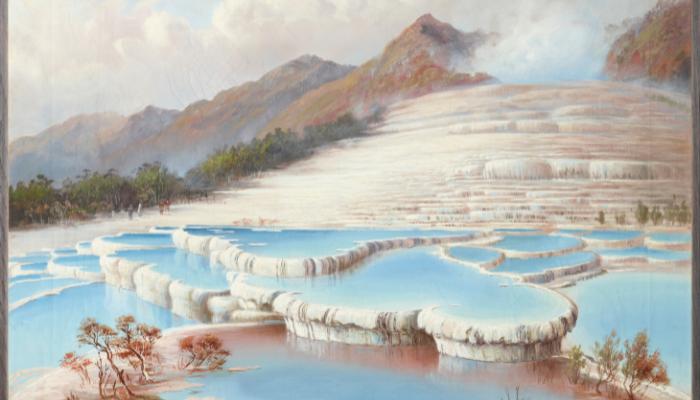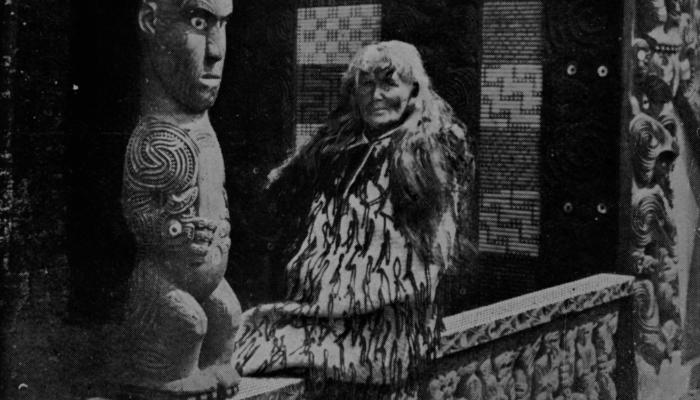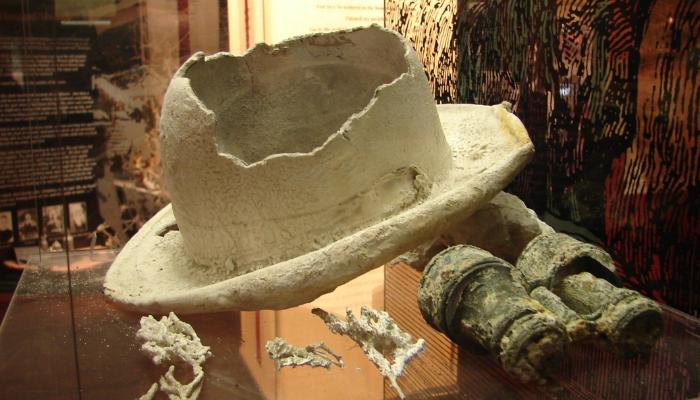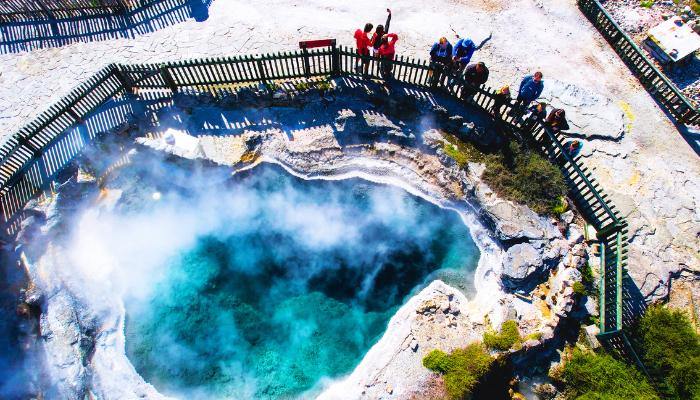When you think of Rotorua, you might conjure images of steaming geysers, bubbling mud pools, and a vibrant Māori culture.
But have you ever wondered how this city became one of our country’s most iconic tourist destinations, and the Māori cultural capital of New Zealand? Let's take a journey through time to explore the fascinating history of Māori tourism in Rotorua.
Te Tīmatanga
Early encounters
In the early 1830s, as missionaries and traders arrived in the Rotorua region, they couldn't help but be captivated by the geothermal wonders that surrounded them. Word quickly spread among visiting Europeans, sparking curiosity about the mysterious landscapes and thermal phenomena of the area.
Recognising the potential for tourism, the local Māori community seized this opportunity. They began showcasing the enchanting geothermal environment, with the Pink and White Terraces (in the painting above) at Rotomohana emerging as the star attractions. These terraces were recognised as one of the Eight Natural Wonders of the World. To fully experience these natural wonders, tourists required knowledgeable guides.

Two notable guides emerged during this period: Sophia (Te Paea) Hinerangi (pictured above), known as Guide Sophia, and Keita Rangitūkia Middlemass, known as Guide Kate. Fluent in English and chosen by the local hapū, Tūhourangi, they quickly transformed their expertise into a thriving business. Tourists paid 15 shillings per tour party, marking the birth of modern tourism in New Zealand.
Te haeremaitanga o te tiuka
The Duke arrives and endorses Rotorua
In 1870, Prince Alfred, Duke of Edinburgh, arrived in New Zealand with his entourage, promoting tourism and trout fishing. This high-profile visit attracted even more attention to our region. Throughout the 1870s, additional geothermal areas, such as Whakarewarewa, were brought to the attention of the European explorers.Te pupuhatanga o Tarawera
The eruption of Mount Tarawera
 Tragedy struck on June 10th, 1886, when the catastrophic eruption of Mt Tarawera destroyed the Pink and White Terraces; the artifacts above were found while excavating the site at Buried Village of te Wairoa. The affected iwi relocated from Tarawera to Rotorua, settling in the thermal valley known as Te Whakarewarewa. During the 1880s, they held complete control over tourist traffic through the geothermal village. Visitors were charged two shillings and sixpence, with one shilling designated as the guide's fee. Guides even carried tourists across the Pūārenga stream for an additional sixpence. Guide Sophia, a renowned figure, was exempt from this system due to her fame, ensuring a steady stream of customers until her retirement in 1890.
Tragedy struck on June 10th, 1886, when the catastrophic eruption of Mt Tarawera destroyed the Pink and White Terraces; the artifacts above were found while excavating the site at Buried Village of te Wairoa. The affected iwi relocated from Tarawera to Rotorua, settling in the thermal valley known as Te Whakarewarewa. During the 1880s, they held complete control over tourist traffic through the geothermal village. Visitors were charged two shillings and sixpence, with one shilling designated as the guide's fee. Guides even carried tourists across the Pūārenga stream for an additional sixpence. Guide Sophia, a renowned figure, was exempt from this system due to her fame, ensuring a steady stream of customers until her retirement in 1890.Ngā wāhine Māori hei kai arataki
The role of Māori women as guides
Traditionally, it was the women of Tūhourangi and Ngāti Wāhiao who served as guides at Whakarewarewa. Some women supplemented their income by guiding, a seasonal but appealing source of revenue. Māori women's natural flair and aptitude for this work solidified their appeal to tourists, strengthening their monopoly in the industry. Guiding harmonised with the traditional roles of puhi (way of life) and kaitiaki (guardian/caretaker) of Māori women, offering them a means to support themselves and their families while engaging in work they enjoyed. The tradition of guiding was passed down through generations, within families connected by blood – a tradition that remains today.Te tīmatanga o ngā mahi whakatipu ngahere
The beginning of forestry and tourism evolves

In the late 1890s, Rotorua saw the inception of the forestry industry, with the first government replanting programme starting here. The men of Whakarewarewa Village provided labour for this programme, forging a connection between tourism and forestry in New Zealand.
As tourism grew, concerns about unregulated practices, including guides rushing tours through the experiences in order to maximize fees, arose. These concerns prompted government intervention. Additionally, land previously owned by local Māori passed into government hands, leading to changes in guiding practices. By the turn of the century, most sightseeing areas, except for the village of Whakarewarewa itself, were under government control, marking a new era in the management of tourism in Rotorua.
Today, as you explore our amazing geothermal wonders and immerse yourself in our rich Māori history and culture in Rotorua, remember how that history has shaped this extraordinary destination. It's a story of innovation, resilience, and the enduring connection between Māori culture and the tourism industry.
Want to explore further?
Whether you’re a history buff or keen to know more about and even immerse yourself into the Māori culture, Rotorua is the best place. Whakarewarewa – The Living Māori Village still offers guided tours and cultural performances, as do Mitai Māori Village, Te Pā Tū, and Te Puia.Guided tours are also available at historic Hell’s Gate Geothermal Park & Mud Spa, via 4WD with Kahukiwi Experiences, a free on-foot tour around Rotorua Museum, and on Lake Tarawera with Totally Tarawera.
Find more information on Māori culture and experiences in Rotorua.



